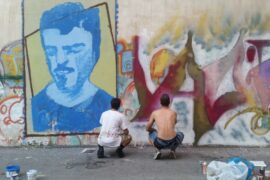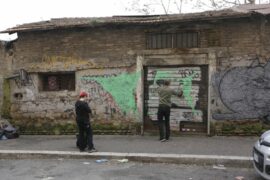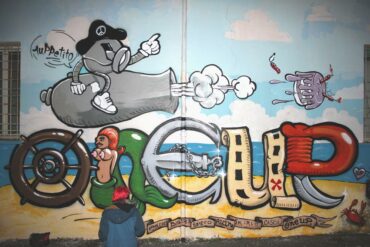Since I’ve started travelling as a “street art reporter”, more than two years ago, I’ve figured out how unpredictable is the impression of different cities on me; some of them just impressed me more than others, with some others I feel a strong and deep connection.
For sure one of the places that I carry in my heart is Athens. I’ve spent there a week in September, but time have flown so quickly: I’ve done the best that I could to seek street art, graffiti, galleries, and of course artists to meet. Since I’ve returned home after that trip I couldn’t stop thinking about going back. I was looking for to having more time to check out and experience more street art and more aspects of Greek lifestyle.
As I’ve written in my previous article about Athens, I’ve felt in love with the local street art, one of the best I’ve ever seen, for variety, quality, political and social impact and quantity.
The massive presence of urban art and its powerful effect and meaning is so evident that it’s impossible to imagine Athens without colourful murales, walls and trains bombed with tags and graffiti, without pieces painted from the top down with sticks and roller by leaning over buildings’ edges, without political slogans and stencils, without all artworks and traces left there by Greek artists and many from other countries.
But let me say that Athens is not only a beautiful and special place because of street art: I like so much the meeting and mixture of ancient and present traditions, the chaotic liveliness of its streets (that reminds me so much some cities in the South of Italy, like Palermo or Naples), the enthusiastic and positive way to approach life and the seeking of freedom, changings and opportunities. Quoting Gilles Deleuze, their kind of art is “an act of resistance” (thank you Tiziano for inspiration!).
For all these reasons I love Athens, and for all these reasons I’ve returned again in January, but this time for three weeks. One of the best trip of my life and a very, very important one. Something I’ll never forget.

Re-discovering Athens: artists, areas and hidden beauty
Thanks to my new professional camera and to my brand new sneakers, purchases that have improved my reporter’s life making it less painful and more itinerant, I’ve spent the first week in Athens walking far and wide, high and low as never before.
One or two days for each area, examining every alley and every centimetre of the walls. Most of the time I was alone, but sometimes I was around with friends. This time the starting point of my exploration, where my accommodation was, has been the anarchic area of Exarchia, my favourite one. Apart Exarchia, as the last time in September, I’ve mainly chose to walk for hours in Psirry, Metaxourgio e Monastiraki areas. Every day new incredible discoveries, dozens of kilometres, hundreds of photos. I know I’ve already described these places to you, but this time is different. I’ve cleared up my mind about many things, I’ve had more times to make questions and get informations and I think is time for a more detailed presentation of artists who painted in Athens.
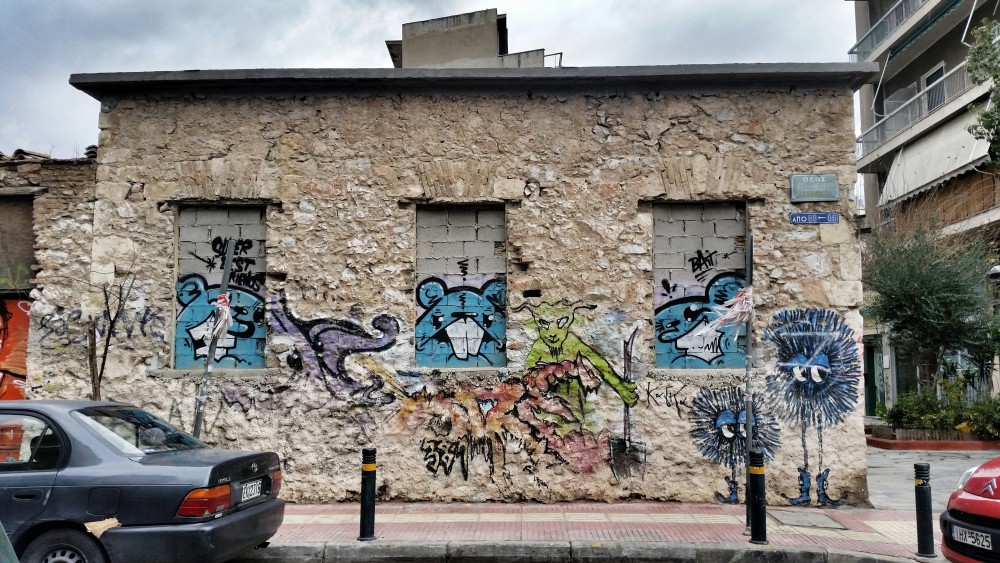
Let’s start, of course, with the local ones. The artists that are probably considered the most important and the more recognizable are INO and Alexandros Vasmoulakis. Both of them have painted commissioned big murals and belong to the local public art scene, but they also painted some smaller illegal murals, that I’ve happily found by chance in different areas of the city. Strolling around you can also bump into some abstract and geometrical artworks by Blaqk and their beautiful calligraphy, into the stylised characters of Sonke and into the colourful ones of B. (thisismybworld). You can also admire many abstract artworks by Cacao Rocks or the ones of N_Grams, the more “spiritual ones” and figurative by This is Opium, many “escaping” characters Exit and his new big paintings always loaded with significance and messages about politic or society, but also murals and posters by Wild Drawing, funny “big man” by ATH 1281, anamorphic portraits by Achilles. Last but not least, you can see many posters by Stmts, colourful graffiti by The Krah (Athenian artist who’ve moved to London), “psychedelic” beetles by Dimitris Ntokos, beautiful paintings by the tattoo artist Dimitris Taxis, stencil cut with its professional tools by (ex)artist-dentist Mapet, bizarre figurative compositions by Ose, dark characters by Yellow Wish and animals painted by Zie, the fat pirate by Dreyk The Pirate.


Talking about artists from other countries who painted in Athens, I’d like to start with Italian friends Bibbito and Mister Dada and our common friend from Argentina, Astro Naut. You can also see a couple of paintings by Spanish famous artist Borondo, some artworks by Danish Malakkai & Lints, stencils by Swedish Hop Louie, and the worldwide famous Brazilian brothers Os Gemeos. But my exploration is not yet finished. Next time more graffiti writing.
First days in Athens: studios, meetings with artists
During the first week in Athens I’ve met my good friend Iakovos Volkov, who’d spent two weeks in Rome with me, I’ve visited the exhibition by N_Grams in Sarri12 Gallery, I’ve met Cacao Rocks and his good friend This is Opium, who were both painting and get prepared for a group exhibition in London, and I’ve also met new people, like one of the guy of a crew who’ve been painting everywhere for long time the word “βασανίζομαι” (I’m suffering).

I’ve also spent two afternoons with the artist Wild Drawing, while he was painting a big mural next to another street art gallery, called Exit (Psirri area). Even though we chatted after my previous trip in September, we met in that occasion for the first time. He confirmed my first good impression chatting online with him and the one of all our common friends who’ve always described him as a “good guy”. He’s such a gentle and genuine person, and was great to spend some time together. We’ve been talking a lot about local street art and about many things. I like so much his “wild” way to approach the wall with stick and roller and his care for details and composition. I also discovered how much he loves Athens and painting there (even though “in some beautiful areas such as Exarchia it’s hard to find free space for painting”) but he also likes travelling and “spreading” his art abroad.

In general, during this week something great has happened: I’ve started to enjoy more my life as “street art blogger”, recognizing artists and styles, but also starting to become familiar to names of the streets, places, Athenian exciting lifestyle, rhythm, folklore, specialities and habits. As the time was passing by, I got ready for my “holiday in holiday”, that was a week in Thessaloniki and Volos.
Thessaloniki, amazing graffiti writing scene (and much more)
So, in a super cold day of January, I’ve said “see you” to my friend Iakovos Volkov at the Athens Railway Station (by the way, be careful taking trains in Greece, because everything is in Greek and totally incomprehensible!) and with my backpack I’ve left, destination Thessaloniki. That was a journey of hope: 6 hours, quite uncomfortable seats, no power outlet. But I took advantage of the situation and decided to switch off my mobile, enjoy the beautiful mountains and trees covered with snow and the end I got absorbed in reading adrenaline-filled stories of graffiti writers. When I arrived in Thessaloniki sun was almost setting. In 40 minutes I run so much that I enjoyed looking at trains painted in the station, I entered an abandoned house, and I’ve taken some photos of graffiti, on my way to the hostel. While walking I started realizing how modern and “international” the city looked like, completely different from Athens, and most of all how amazing that graffiti were and how bombed were the streets. Was immediately clear that quality was great, especially the one of the 2 main crews, 381 and 420. Big up!

My “travel companion” for three days was a very kind guy and talented writer, Pars.
First day together we’ve visited two abandoned factories, in an industrial area on the outskirts of city. In the first one he showed to me some old graffiti he made some years before, and also some old ones by Iakovos Volkov, who was a graffiti writer, member of a crew called Tsimuha, together with his friend Pralina.
The second abandoned factory was a big complex of dirty and crumbling factories. And I liked it so much. While walking I observed rooms without roofs, holes in the floors and even two collapsed, one completely covered with a layer of ice cream and yogurt paper buckets, dust and garbage everywhere, of course watching at the same time paintings on walls.
 Great to take photos of interesting artworks by Pars and Pralina, but what surprised me even more was the quantity and quality of the paintings by Iakovos Volkov: I felt like being in a old exhibition with his pieces. There were many graffiti and figurative experiments, both with writings on a side, and in the last part of the factories his first installations. Finally I’ve also seen in person the famous room of “One thousand sorry”, even though unlikely it was quite faded and the place too dark to take a picture. Pars pointed out that many murals there have been faded, lost intensity and even changed colours, as a consequence of time and maybe because of chemical and atmospheric agents.
Great to take photos of interesting artworks by Pars and Pralina, but what surprised me even more was the quantity and quality of the paintings by Iakovos Volkov: I felt like being in a old exhibition with his pieces. There were many graffiti and figurative experiments, both with writings on a side, and in the last part of the factories his first installations. Finally I’ve also seen in person the famous room of “One thousand sorry”, even though unlikely it was quite faded and the place too dark to take a picture. Pars pointed out that many murals there have been faded, lost intensity and even changed colours, as a consequence of time and maybe because of chemical and atmospheric agents.
When the visit to the factories was finished he showed me a hall of fame and then we returned to the city center. Great exploration indeed.
 We’ve spent most of the second day in the Upper Town, which is the most ancient area of the city, in the north. The area is approximately 2300 years old and is the only part of the Thessaloniki that survived the big fire of 1917. Only in this picturesque and unique place called “Ano Poli” you can find stone paved little streets surrounded by small beautiful colourful houses, ancient Byzantine wall and rest of churches and towers… and tags and graffiti everywhere! Of course some of them have been painted by Pars, Iakovos and some other writers. What was a bit weird and beautiful at the same time was this combination of past and present, historical and decay. I couldn’t believed how many houses were abandoned, some of them partially collapsed. I couldn’t resist, I knew it was risky but I decided to enter, alone, in a couple of them while in another one Pars climbed a stone wall (let’s say we both are a bit crazy, in different ways) to take a photo with my camera at the amazing panoramic view of the city and sea, which is one best thing of the Upper Town.
We’ve spent most of the second day in the Upper Town, which is the most ancient area of the city, in the north. The area is approximately 2300 years old and is the only part of the Thessaloniki that survived the big fire of 1917. Only in this picturesque and unique place called “Ano Poli” you can find stone paved little streets surrounded by small beautiful colourful houses, ancient Byzantine wall and rest of churches and towers… and tags and graffiti everywhere! Of course some of them have been painted by Pars, Iakovos and some other writers. What was a bit weird and beautiful at the same time was this combination of past and present, historical and decay. I couldn’t believed how many houses were abandoned, some of them partially collapsed. I couldn’t resist, I knew it was risky but I decided to enter, alone, in a couple of them while in another one Pars climbed a stone wall (let’s say we both are a bit crazy, in different ways) to take a photo with my camera at the amazing panoramic view of the city and sea, which is one best thing of the Upper Town.
In general, we both felt like the time had stopped in that place and like being in a mountain small town, where the inhabitants look cheerful and suspicious at the same time, and everybody say “hi”… and something else in Greek I didn’t understand!

After 3 hours we’ve decided to go back to “civilization” of the city center, I’ve taken some other photos of walls, then, before separated for a while, we’ve spent some time at the graffiti shop called Box Gallery, where I bought two sprays and a book about Taps and Moses, even though I would have bought so many others about graffiti in Greece. Next time!
Before meeting again for dinner, I had some hours off and decided to go the port, to see the last sunset of that exciting trip in Thessaloniki, walking down by the sea.
While watching at the sky and its beautiful pastel colours reflected on the calm surface of the water, it started again to rain but I decided to stay still, without umbrella, to enjoy the view and the moment. I sighed, aware that a feeling like that must be kept in the heart, for long time.
Volos: mountains, sea, colours and graffiti
Another long journey to get to Volos from Thessaloniki, 4 hours by bus. But I love travelling by bus in Greece, it reminds me so much travelling in Sicily and it’s always a good occasion to discover something. This time, looking outside the window, I’ve seen some interesting abandoned places, like a train station, a big and old drive-in and a huge factory. Once arrived in Volos, I was happy to meet again my second “travel companion” for three days, the writer Biz. He had already prepared, as Pars before, an itinerary for me.
I must say I’ve been so lucky and grateful for their company, they are very good guys.

First afternoon together with Biz we have been, have a guess! in an abandoned factory. It was not so far from the city center and we were quite visible from outside, but he said it was safe. Needless to say, it was full of graffiti. I could recognize some styles, but he also explained many things and showed his pieces to me.
Then we’ve stopped in a room without roof: he started painting while I took some photos at him and around the factory.
We talked and laughed while time was passing by in this silent and quiet place. But when we decided to leave the room something unexpected happened: there were two horses staring at us, a bit threatening. Honestly, in all of my life, I could have never ever imagined to stumble on horses in an abandoned place! Was almost funny.
Happy but a little frightened, I said to Biz that maybe was time to move on.

After that we’ve quickly visited the university and then, just before the sunset, he took me to a hill, to enjoy the best panoramic view of the city, the mountains and the port.
He summed up the history of Volos, one of the country’s most important commercial ports and very busy with cargo boats, and its changes after the crisis (many shops closed, many unemployed people), and ended with some thrilling cool stories about his life as a graffiti writer, especially the ones in which he narrowly avoided being caught by the police. I could listen to stories like these for days, no joking.
After dinner he showed me the small and quiet city center and then we met Pantoflas, graffiti writer and organizer of one of the most important graffiti and music festival in Greece, Beach Street Festival in Lesbos. We’ve spent a nice night at the pub and we’ve met him again the following day, for long interesting chats about graffiti stories, anecdotes and fanzines. Great meetings and conversations, I really want to thank him for the good time we had together.
Second day in Volos started with a visit of one of the most beautiful area of the city, near the port, then he said “now let’s go in one of the biggest abandoned factory you’ve probably ever seen”. And it was! If I was there alone, for sure I would have got lost. I was also astonished by the amount of graffiti. He explained that there’s almost no scene in Volos, most of them were painted by passing crews and writers, like him, not local ones. I have seen so much, learning so much. We just stopped for a while to wait for a passing train, to take a photo, and we’ve spent one hour in one room. He painted, while I took some photos and decided to try to paint as well something very small, in a corner, with the spray cans I’d bought in Thessaloniki. Of course it was a “toy piece” but I had great fun! (I sent the photos to some good friends, writers, they said it was cute and persuaded me to publish the photo!)


When we’ve finished, Biz was so nice to take me to the port, to see a mural by Os Gemeos (he knew I love them). First he showed me a big roller piece he painted by leaning off a roof… on the building of the university! Then we took some pictures and enjoyed the sunset. That place was beautiful. We’ve ended that day meeting Pantoflas … and then again hours of chatting about graffiti and many other stuff.
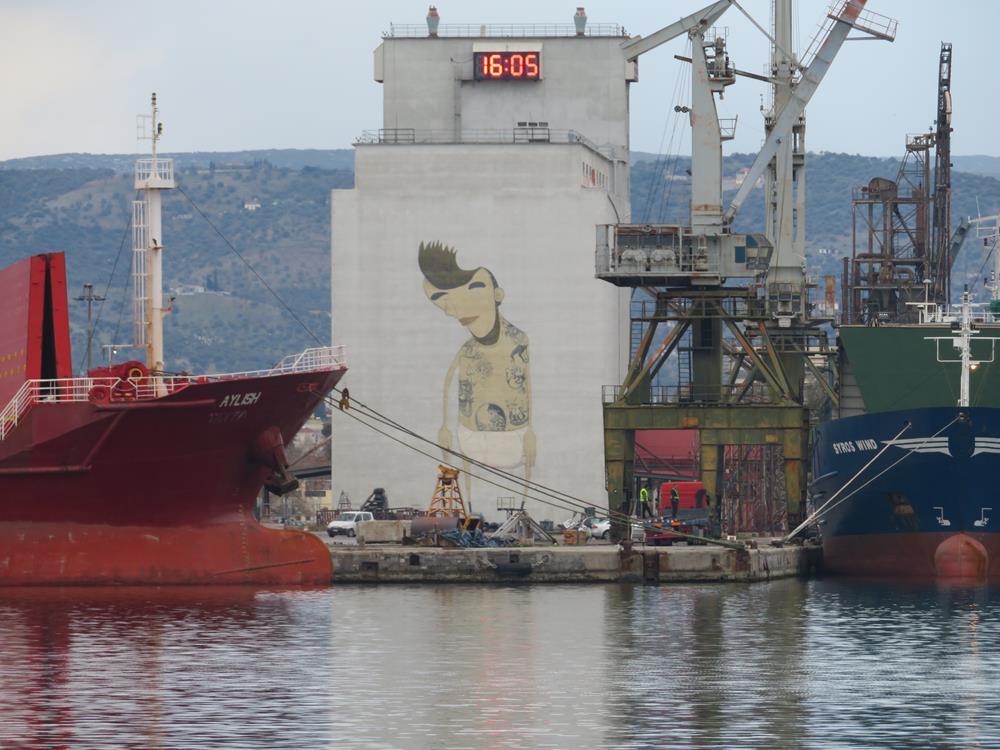
On Saturday I had to leave and I was a bit sad that that trip was finished. Again, one very long journey by bus (6 hours), looking outside the window.
It was great to be back in Athens! So many positive feelings, memories, names to remember, gifts and dedications on my backpack. And still so many days of travel and adventures to come.
Last 10 days in Athens: live like a local
When I returned to Athens I had a strange and wonderful feeling: I felt like I was back home, from a holiday, even though I was still on holidays! As never before I’ve finally spent my last days like a local, experiencing like never before routine, habits, tastes of Athenian people and friends. I’ve fully enjoyed both daylife and nightlife, tasting typical restaurants, chatting with many different people, having dinner with friends (thank you N_Grams for your yummy pizza!), visiting Onassis Cultural Centre at night and the Omonia Hotel for a daily event, where I met my Italian friend Mauro Filippi, Street art Palermo!
The area I’ve enjoyed and appreciated much, also during the night, was Exarchia (for this, I must thank Exit). One day also have the chance to see one American crew, MTA from San Francisco, bombing the street during the night (thanks Iakovos for giving me a call to say to reach him there). The guys were so friendly, we’ve chatted a bit. I’ve discovered they’ve planned one week in Athens and Thessaloniki and I was surprised to know how equipped they were… they’ve even brought some folding ladders with them, on plane! Was great to meet them and see them in action. This is Athens!!
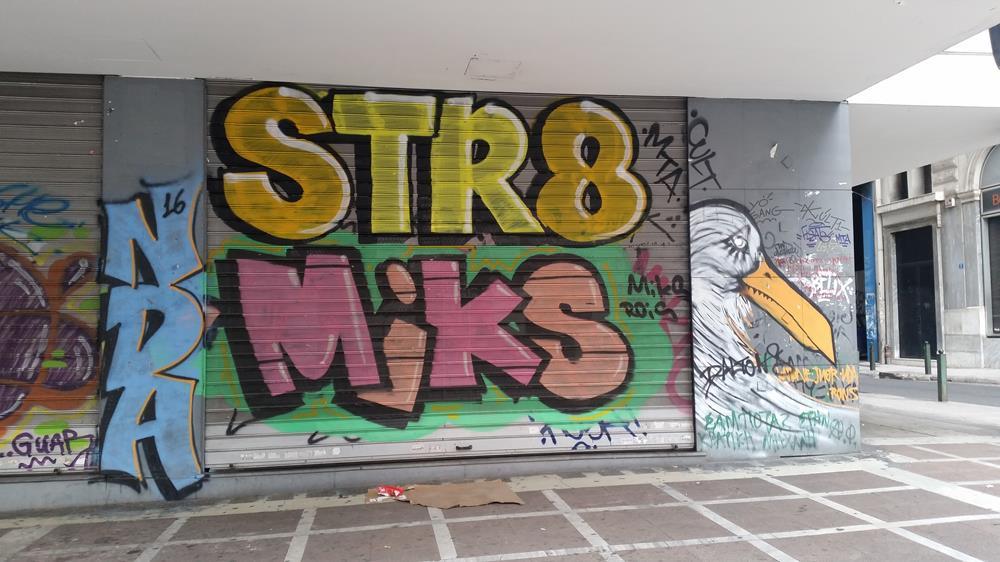
By the way: to see more graffiti as possible, in these last days I’ve also taken many times the green line and I’ve visited a couple of hall of fames. Of course, I suggest you to do the same.

Exarchia, a village in a city. Graffiti and voices of dissent
First of all, you can’t affirm you know Athens if you’ve never been in Exarchia. In my opinion any article about street art in the capital city of Greece that doesn’t mention walls of this area, is incomplete. If you want to visit Athens for a short time, my tip is to take at least three hours to walk around the area. But please keep in mind that more than in any other place in the city, for a better and greater understanding you need time, days of explorations and not least you need to talk with locals, listen to opinions and someone who can translate Greek slogans and words on the walls.
I also suggest you to read many articles, books and essays, like the one written by the anthropologist Pafsanias K. (valuable source of informations), and also check out the blogs Aesthetics of Crisis and InExarchia (thank you guys for your tips, before and during my stay in Greece).

What I want to do is tell you what I’ve learned about Exarchia. It’s just my report and my personal and outspoken opinions (you know, I never worry about what someone might think of them), but I hope you’ll appreciated and integrate it if you’re interested in this kind of street art.
Before having together a virtual walk into this area, I want to start by saying something about recent facts. About two years ago Municipality of Athens started an anti-graffiti campaign, to clean up the city, make it “more beautiful”, catch and erase any sign of “vandalism” and give back to the streets an image of “respectability and order“. Not my words, of course. I just report what I’ve listened to and read. You know what’s my opinion about this bullshits.
Needless to say that, as in many other cities in the world with similar situations, this process is arbitrary, this kind of causes are embraced and supported by people who doesn’t know anything about art, let alone street art and graffiti. Moreover, in most cases, municipalities don’t care about the political and social history and value of street art; they never involve or just listen to local scene or take a simultaneous initiative of education, information and learning (also to stop the real vandalism) into account.
In Italy, we know very well the modern trend of “open-air street art museums”, a new form of decoration as a form of “revitalization”, as if a mural could substitute for a retraining of an area. Most of these initiatives are just lark-mirrors and a cunning and cheap solution to limit underground scene and to hide or make inhabitants forget lack of interest and projects that could improve quality of life, in any possible way.
Let’s go back to Athens. So, in the last years there were some initiatives and events of public art similar to the ones in Italy, and in general an increasing attention for muralism. What about street and graffiti? The truth is, in my opinion, that anti-graffiti campaign is trying censor ideas, Municipality wants to repress the scene and limit the right to freedom of thought.
Talking with experts of political street art and with some local artists, I’ve found out that also media are partly responsible. In fact many journalists and “street art lovers”, from Greece or other countries, analyze only some aspects of illegal street art, and romanticize it too much. Their focus is figurative art, the one more “beautiful” and easily understandable, but they find less interesting to write about graffiti and stencil art.
As I’ve always said, “a small poster or stencil can be one thousand times more powerful and creative than a big 9-floor mural”. And many pieces in Exarchia area are proof of this.

Only few people really make an effort and invest time trying to understand or support art of dissent of Exarchia, the one more connected to real political problems and local life.
The other big problem is that, when this people mention it, doesn’t matter if with good intentions, they tend to underline that this kind of art and “rebellion” is a consequence of crisis. That’s not true! Thank you so much to local persons who really opened my eyes about this. The truth is that illegal street art had been existing for years before crisis. To see it as a consequence of it, it’s just what’s more politically convenient. Easier to blame economical problems than investigate to all the others, and than “wasting” time trying to understand the voices of the people who inhabit the city in its everyday life.
Exarchia has been such a lively cultural and artistic area since ten years, with an ongoing transformation. Except for some “street art” artworks, like the ones of Wild Drawing and Exit, walls are mainly covered with political stencils, posters and slogans, some drawings of local residents (especially of occupied houses), and of course plenty of tags, throw-ups and graffiti. Many writings are anarchic, both in Greek and English, like “Fuck the police” or “We hate the police”, but some of them are ironic. You can find many messages and opinions about current events, immigrants, refugees and clashes with the police.
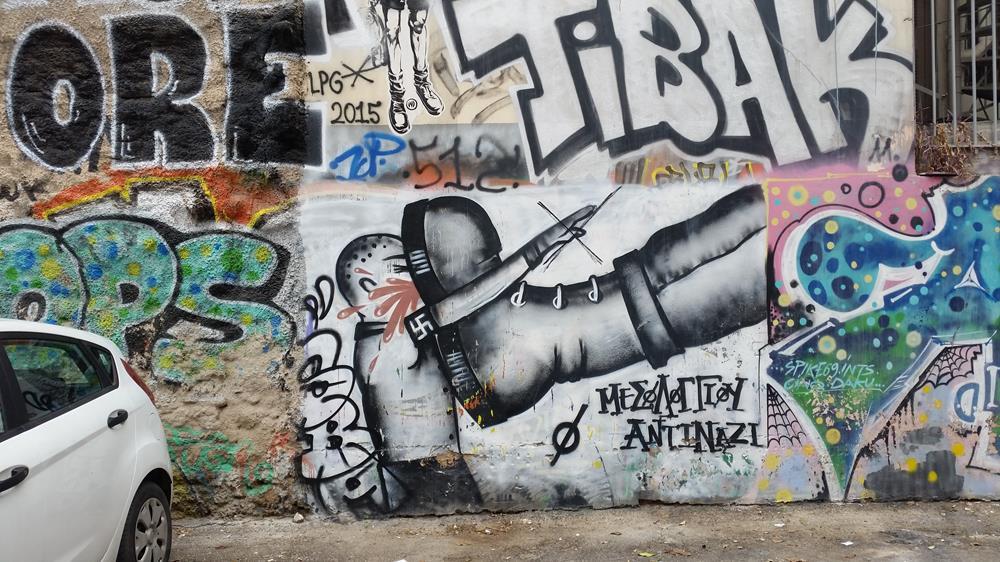
By the way, something you can’t miss if you go to Exarchia and it should be include in a “street art tour”, is the Shrine to Alexander Grigoropoulou, the 15 years old boy who was shot by the police during the famous riots of December 2008, which is on the corner of Mesolongiou, now unofficially renamed Alexander Grigoropoulou Street, and Tzabella street.
People often leave flowers and personal things in his memory, and the wall is full of intense graffiti and messages. One of them is a stencil, a depiction of Berkin (‘saying you are my brother’), a Turkish 15years old kid who died by the police in Istanbul during the Gezi Park demonstrations in 2013. It was done in Exarcheia by Greek anarchists as an answer to another stencil that was made in Istanbul by Turkish anarchists for Alexandros Grigoropoulos in 2008.

On the opposite wall there’s a work dedicated to an anarchist who died in a gunfight with police, and next to it there’s another one dedicated to Killah P. (Paylos Fyssas), an MC who was murdered by Golden Dawn (the greek neo-nazi party). Just two minutes by walk from this corner there’s another place not to be missed, the famous parking between Manis street and Mesologgiou. Moreover, don’t forget to visit also Univerisity of Athens and Politechnion.
Let me say that every time I’ve visited Exarchia I’ve discovered something new. It’s clear that residents try to keep the area clean, it’s almost impossibile that police enter (except strikes or riots or rare occasions) and in general I’ve never seen junkies or fights.
So, please, don’t be influenced by those who say it’s a dangerous place full of criminality and riots. This, of course, doesn’t mean that you don’t have to be careful, as in any other place in the city. What I’ve found in this area is cheerful and smiling people, many students, families of different social classes, immigrants. And I’ve realized that this is also the best area to fully enjoy the athenian folklore! Best place for health food, taberna, pubs, night clubs, vinyls shops, vintage shops, quite and nice cafes with wi-fi, fast foods. It’s also full of bookstores and publishing houses, that shows once again that Exarchia promote creation and freedom of expression.
Quoting an article I’ve found about Exarchia, “If you wander around you will certainly find something that interests you, maybe something that you thought would not interest anyone but you”.
The very last thing about this lovely area is a place I found by chance, that is now one of my favourite in Athens: you can’t miss the beautiful view of the city, from Strefi Hill.
Being there, despite being afraid of heights, was magical. Can’t wait to sit there again, in the summertime.
Back to “Nar’s abandoned factory”: dust and installations
During 2 weeks in Athens I’ve spent some days with my friend Iakovos Volkov, one of them in “his” abandoned factory, where I’ve already been in September. As always, it was great to talk with him about his art projects and ideas, he’s so creative!
During the day I’ve taken some photos of old pieces, admire his last installations and also see him starting a new one. It’s so exciting to think that next time I’ll probably find the place with new stuff, is like a solo exhibition getting bigger and bigger! That’s of course just a personal project and anything can happen to the place, you can never know, but I really hope to return there soon.
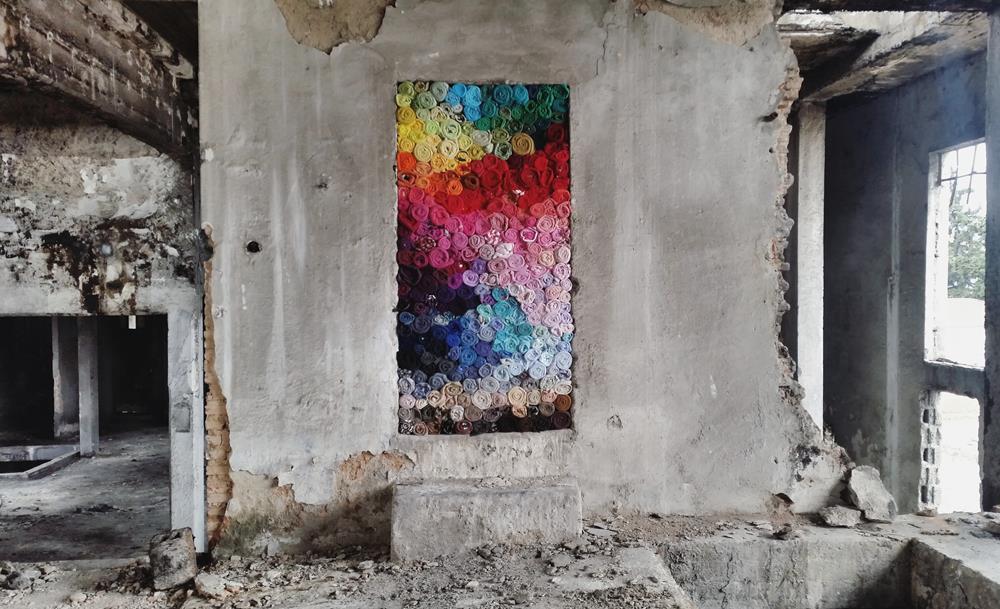
Painting day (with final surprise) with Exit and N_Grams
One of the best experiences of my travel has happened just 3 days before leaving.
My friends Exit and N_Grams, in fact, have decided to organize a “painting day” for me, in Metaxourgio area. Exit had to finish a piece he started some time before, adding a new character and a writing, while in the upper part of the wall there was enough space for N_Grams. It’s indeed a very good spot: on the corner of a busy street, so many people and cars passing there every day. With me and the artists there was also Mauro Filippi-Street art Palermo (thank you for the photos!), who was excited too to see them painting before leaving (that was his last day in Athens). While N_Grams was painting with a stick and a roller and Exit was using an unstable mountain of garbage as it was a ladder, me and Mauro have been talking, taking photos and also looking at the curious faces of passers-by. With my surprise I could even understand some Greek comments!


Both artworks were beautiful, and the artists satisfied and happy. But when they’ve almost finished, something unexpected suddenly happened. Just when me and Mauro were taking a funny selfie for our common Italian friends… the police arrived!
They said the artists had to stop and we all had to quickly clear out the place and follow them with car to the police station. We were quite calm and optimistic about what was going to happen. I must say that it was also a bit funny and exciting experience! And Mauro and me considered it as an important occasion of street art reportage and fieldwork.
We had to stay in the police station for 3 hours but we’ve chatted a lot, while Exit took some funny selfies.

At a certain point one policeman started yelling at Mauro, because he was talking too loud, and said “Malaka”. Since I knew the translation of that bad word it was hard for me not to burst out laughing! (I’ll then translate it to him, it’s “motherfucker”).
Everything was tragicomic. Anyway, exactly when we were seriously thinking about ordering a pizza, the policemen ask us to enter the office, we had to provide our personal details and at the end there was a long but calm conversation between them and the two artists, something like “don’t do it anymore”. So, all’s well that ends well!
Mauro had to rush to the hotel and me, Exit and N_Grands spent the rest of the night in Exarchia, in a typical taberna, eating, drinking wine and laughing. The perfect end of a memorable day!
Thank you once again Greece, see you soon!
In Italy we have an expression for “nostalgia for Africa” which is more or less “suffering of African blues”. Well, I have the same sickness, but for Greece! Wasn’t so easy to leave Athens. I spent the last day of my “holiday” walking for two hours in Exarchia, drinking a big orange juice (I was getting sick, just in time!). After that, before going to the airport, I published this post on my Facebook profile:
That perfectly summarize my wonderful trip and… everything. I want to thank with all my heart all good people who helped me, spent some time with me, listened to me, laughed with me, shared good moments, talks and opinions. I also want to thank all the artists that I’ve had the pleasure to meet, most of all I want to say a special thanks to Iakovos, Exit, Biz and Pars.
I’ve returned to Italy with my heart full of joy and with so many photos, emotions, new friends, and reasons to get back (in May). Thank you Greece.



